ISSN: 2320-0189
ISSN: 2320-0189
Postgraduate Department of Botany, Kisan PG College, Bahraich ? 271 801, Uttar Pradesh, India
Received date: 20 May 2012 Accepted date: 25 June 2013
Foliar fungi, Susceptible Hosts, Status, North Tarai Forest, Uttar Pradesh
Visit for more related articles at Research & Reviews: Journal of Botanical Sciences
The present report elucidates a rich and unique profile of Mycobial as well as Phytodiversity of research area surveyed with two hundred four angiospermic host plant species representing one hundred fifty two genera of sixty three different families being parasitized by two hundred thirty seven fungal species representing sixty three fungal genera. The survey and documentation has resulted more than twenty one new host records and twenty three new fungal species to Indian mycoflora.
The leaves provide a very suitable habitat for the growth & development of fungal pathogen by providing ample surface area and nutrient supply. Such leaf inhabiting fungi are known as Foliicolous fungi and the invaded area of the leaf appears as leaf spot or leaf lesion. The weed and forest plants serve as reservoir of leaf spot pathogen which on getting opportunity may spread to agricultural and horticultural plants.
World constitute twenty mega diversity countries in which warm tropical region between the tropic of cancer and tropic of capricorn on either side of the equator (between 23½◦N and 23½◦ S around the globe) have since long provided the most suitable habitat for living organisms with a rich and diverse plant, animal and microbial life forms constituting twelve mega diversity countries. The twelve mega diversity countries constitute about 65% of the total biodiversity.
India is one of the twelve mega diversity countries of the world has two of the world’s eighteen biodiversity hot spots located in the Western Ghat and in the Eastern Himalayas. In north of North Tarai Forests, the Himalayas rise as a virtual wall beyond the snow line. Above the alluvial plain lies the Tarai strips, a seasonally marshy zone of sand & clay soils. The Tarai has higher rainfall than the plains and the downward-rushing rivers of the Himalayas show down and spread out in the flatter tarai zone depositing fertile silt and reproductive means during the mansoon season and receding in the dry season. The Tarai, as a result has high water level and is characterized by moist sub-tropical conditions and a luxuriant turn-over of green vegetation all the year around. The climatological and topographical conditions favour the luxuriant growth & development of foliar fungi. This North-Tarai region of U.P. is next only to Eastern and Western Ghat as one of the hottest spots for biodiversity in general and the diversity of fungal organism inhabiting plant leaves in particular offers an ideal opportunity for the morphotaxonomic exploration of fungal organism in general and foliicolous fungi in particular [12]. The Foliicolous Fungi causes huge losses every year in different parts of world. The fungal pathogens producing leaf spots infect a large variety of hosts including most of the crops, forests and other plants. The destruction caused by these enemies of leaves is a serious problem before us. The focus of this research is identification & documentation of foliicolus fungi which will assist in the discovery of new fungicides and ideas to overcome from the severity of these enemies of nature as well as in the protection of floral diversity from the infection of these pathogens and also in the conservation of valuable flora of the area. Keeping this in view the authors surveyed the North Western Tarai forests of U.P. which include East & West Sohelwa, Shrawasti, Bahraich forest division, Katarniaghat Wildlife Sanctuary, Dudhwa tiger Reserve, Kishanpur Wildlife Sanctuary and Pilibhit Forest Division during July, 2006 to September, 2011.
During collection, infected leaf samples were taken in separate polythene bags. Suitable mounts of surface scrapping and hand cut sections were prepared from infected portions of the leaf samples. Slides prepared in cotton blue lactophenol mixture were examined and camera lucida drawing were made which seems to be new as described by Verma et al., 2008 and Mall, 2011. Morphotaxonomic determinations of taxa were done with the help of current literature and resident expertise available. All the fungal taxon were identified after making microscopic preparations and later confirmed by Prof. Kamal, Emeritus Scientist (DST), DDU Gorakhpur University, Gorakhpur. The fungal Holotype specimen has been deposited in HCIO, IARI, New Delhi. References given in the text has also been provided with their wave links which are available.
The authors surveyed periodically the very diversified habitat of North Western Tarai Region of Uttar Pradesh during July, 2006 to September, 2011 so as to collect and document foliicolous fungi. The author collected two hundred four angiospermic host plant species representing one hundred fifty two genera belonging to sixty three different families being parasitized by two hundred thirty seven fungal species representing sixty three fungal genera. The host plants and their parasites are enumerated below-
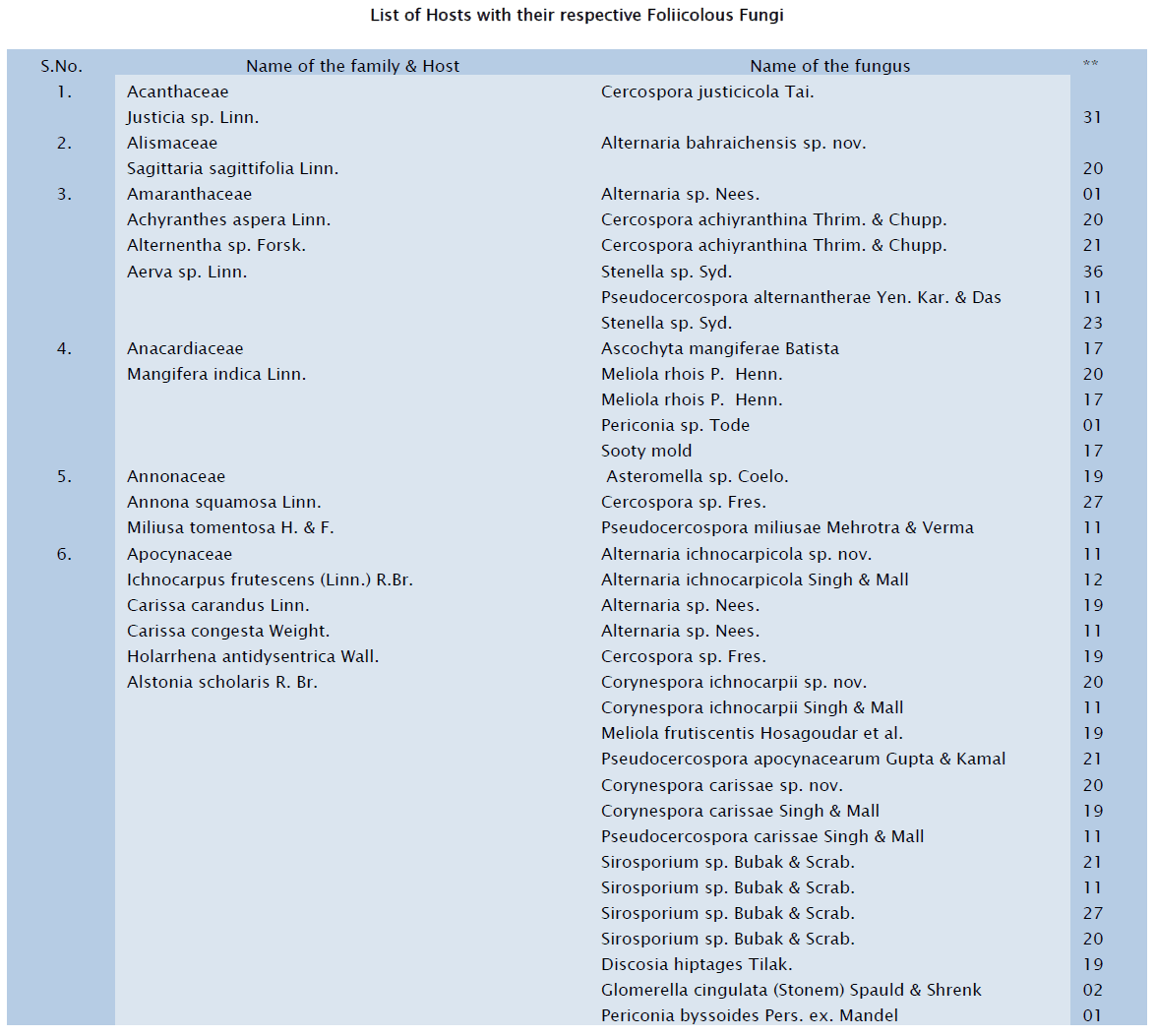
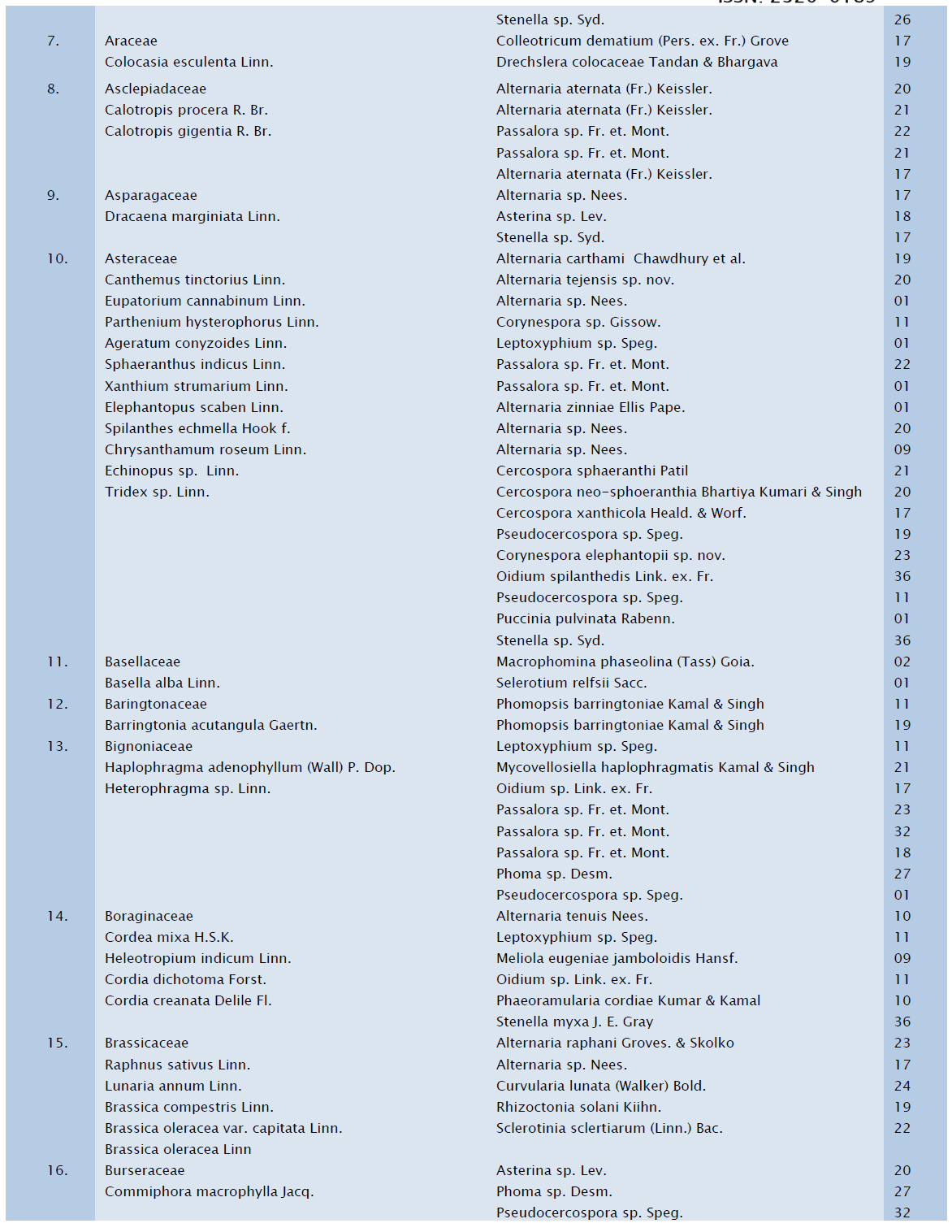
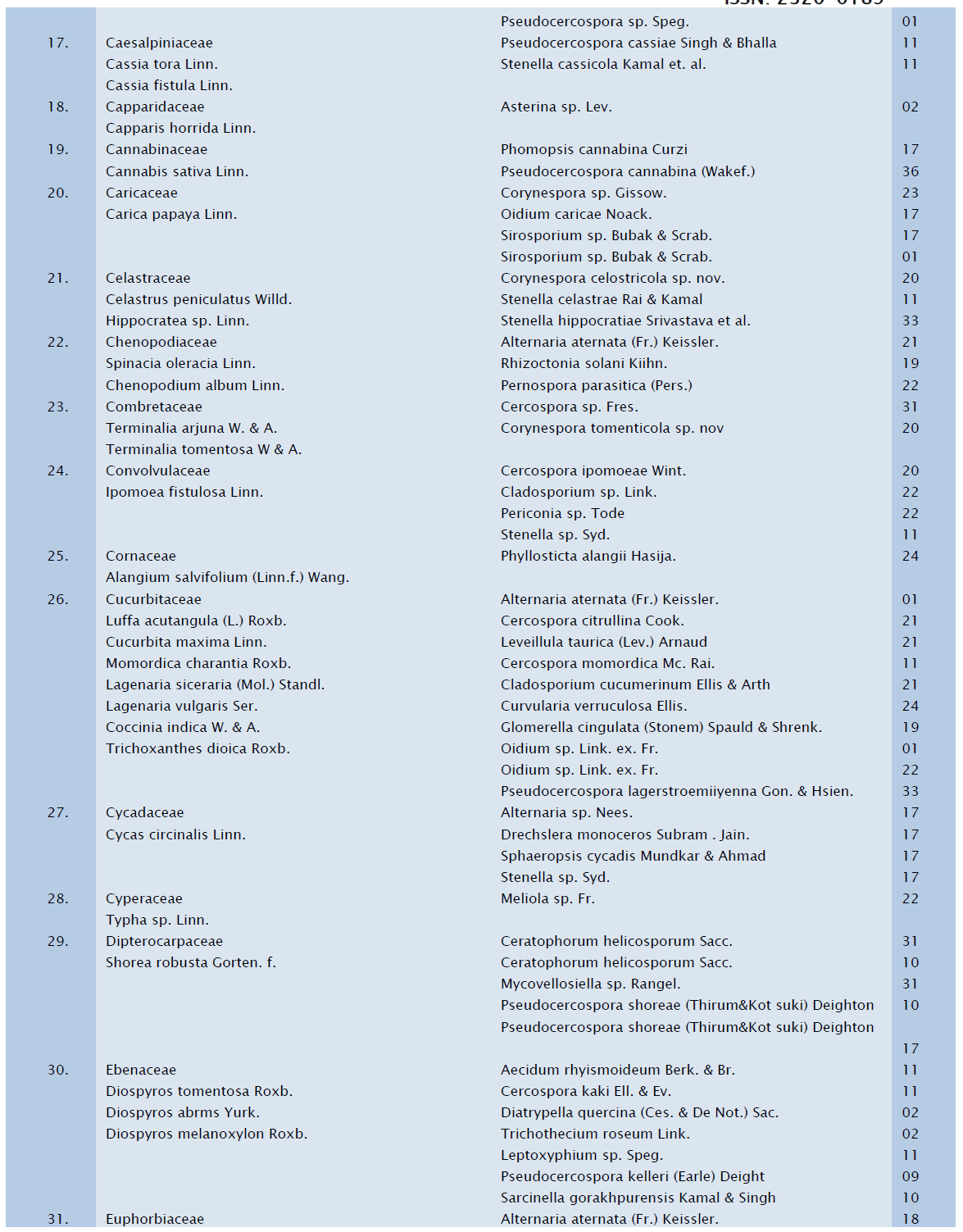
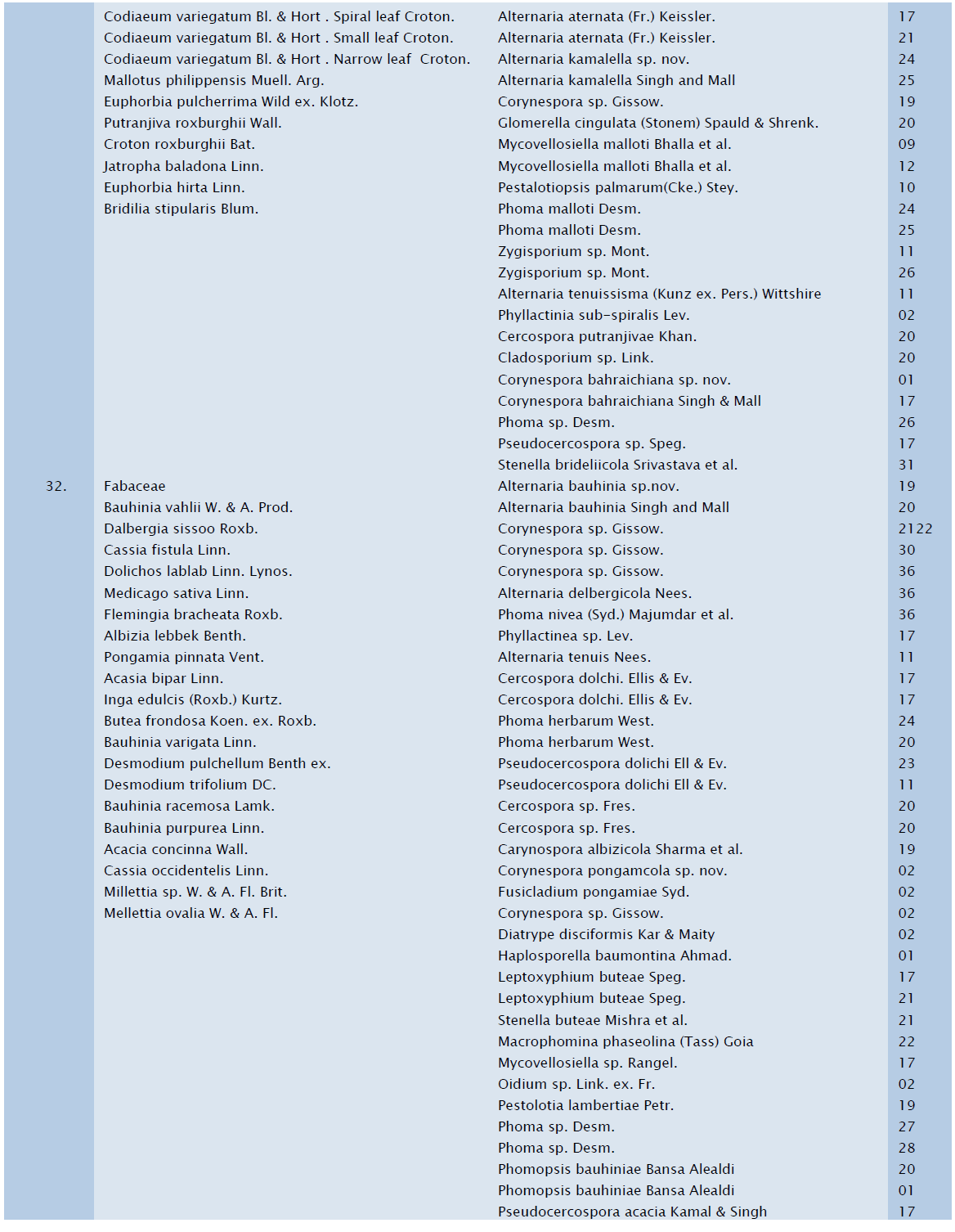
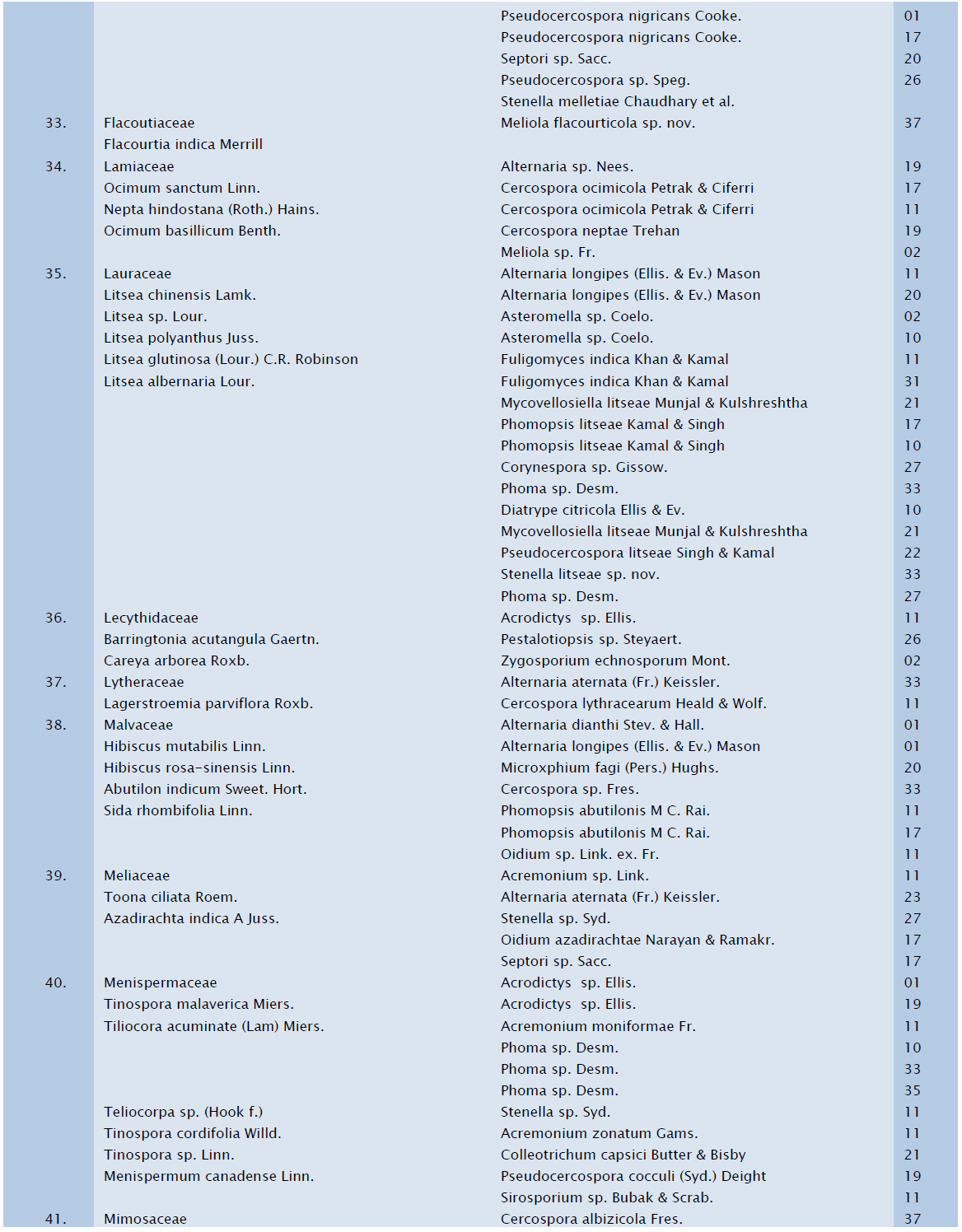
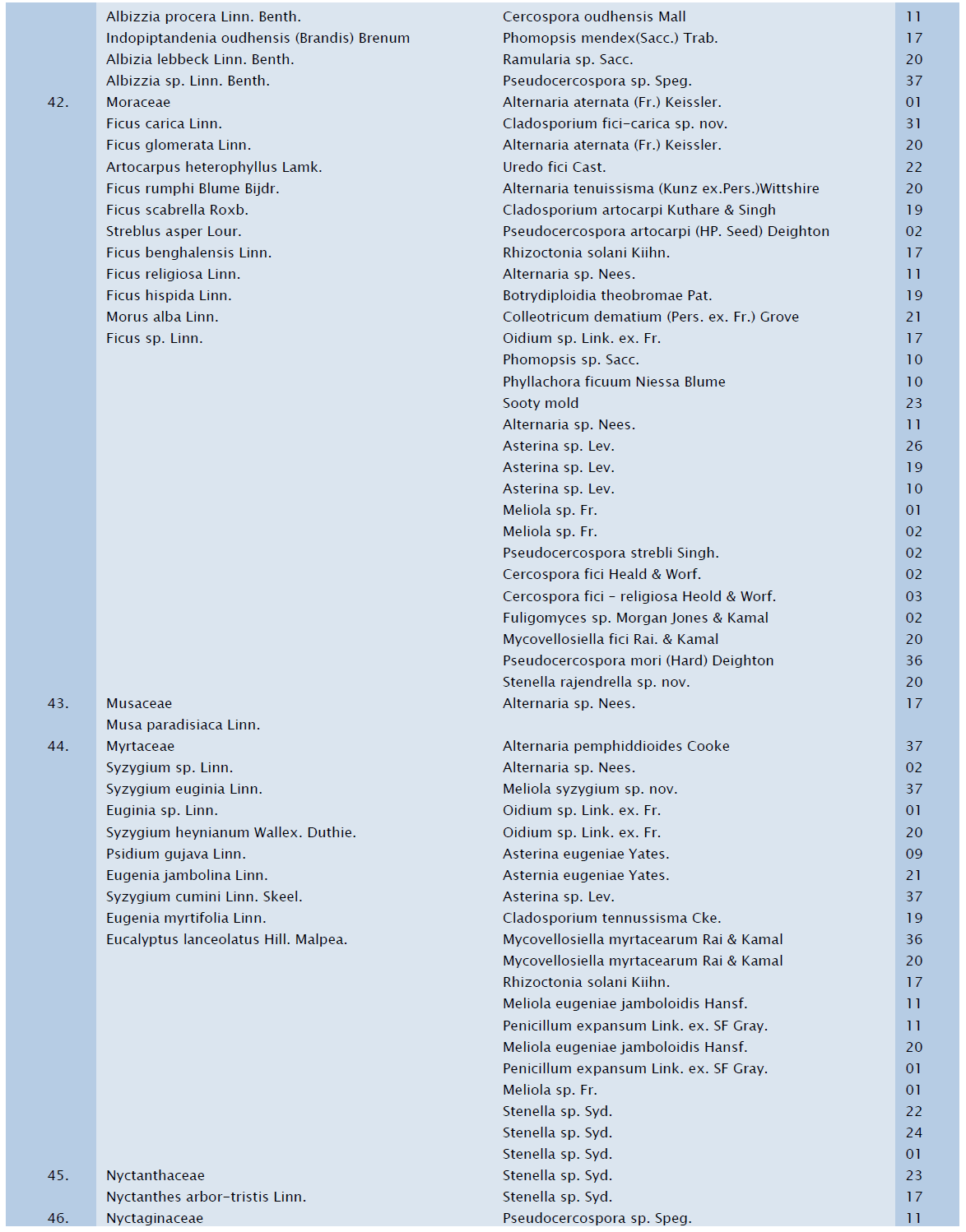
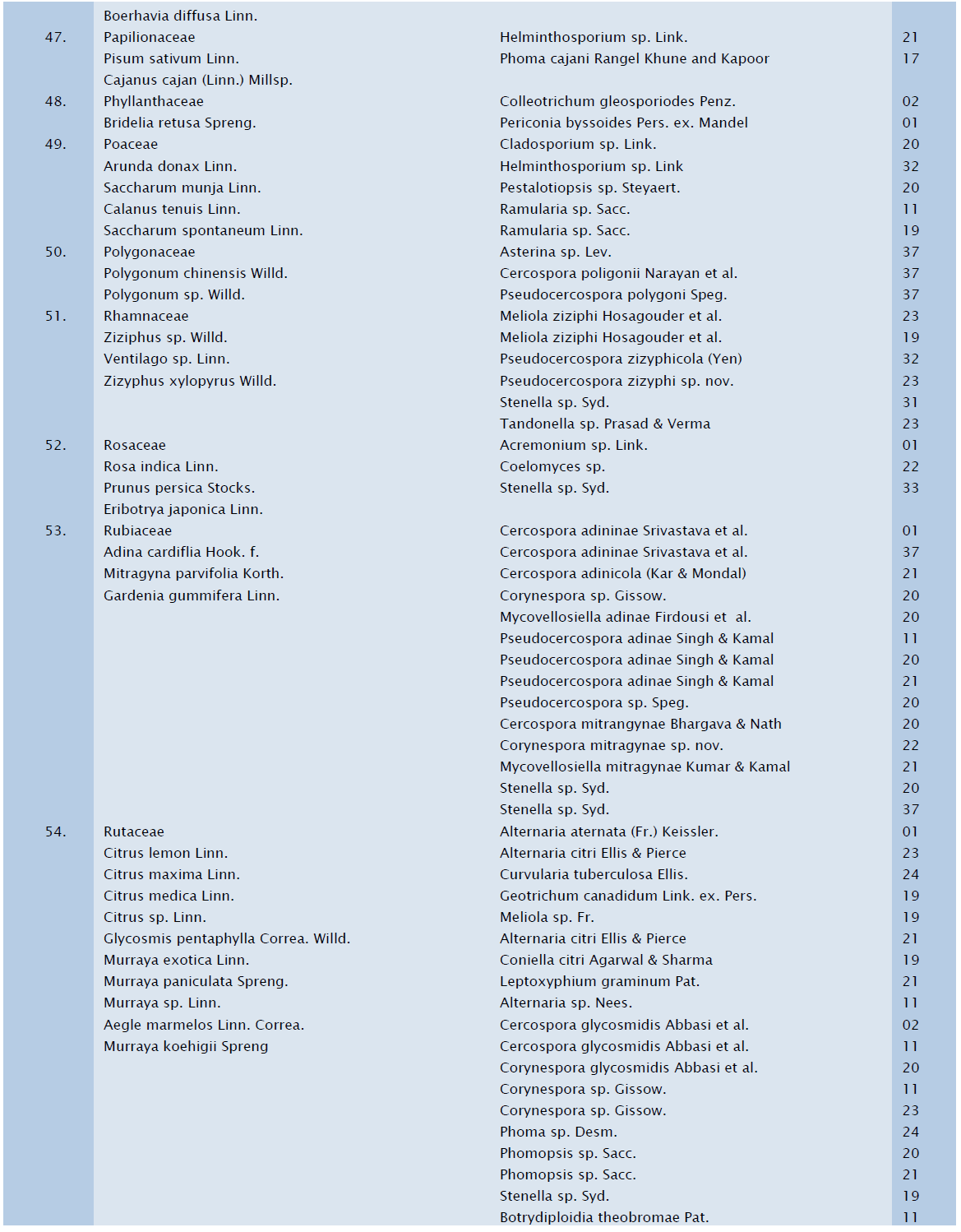
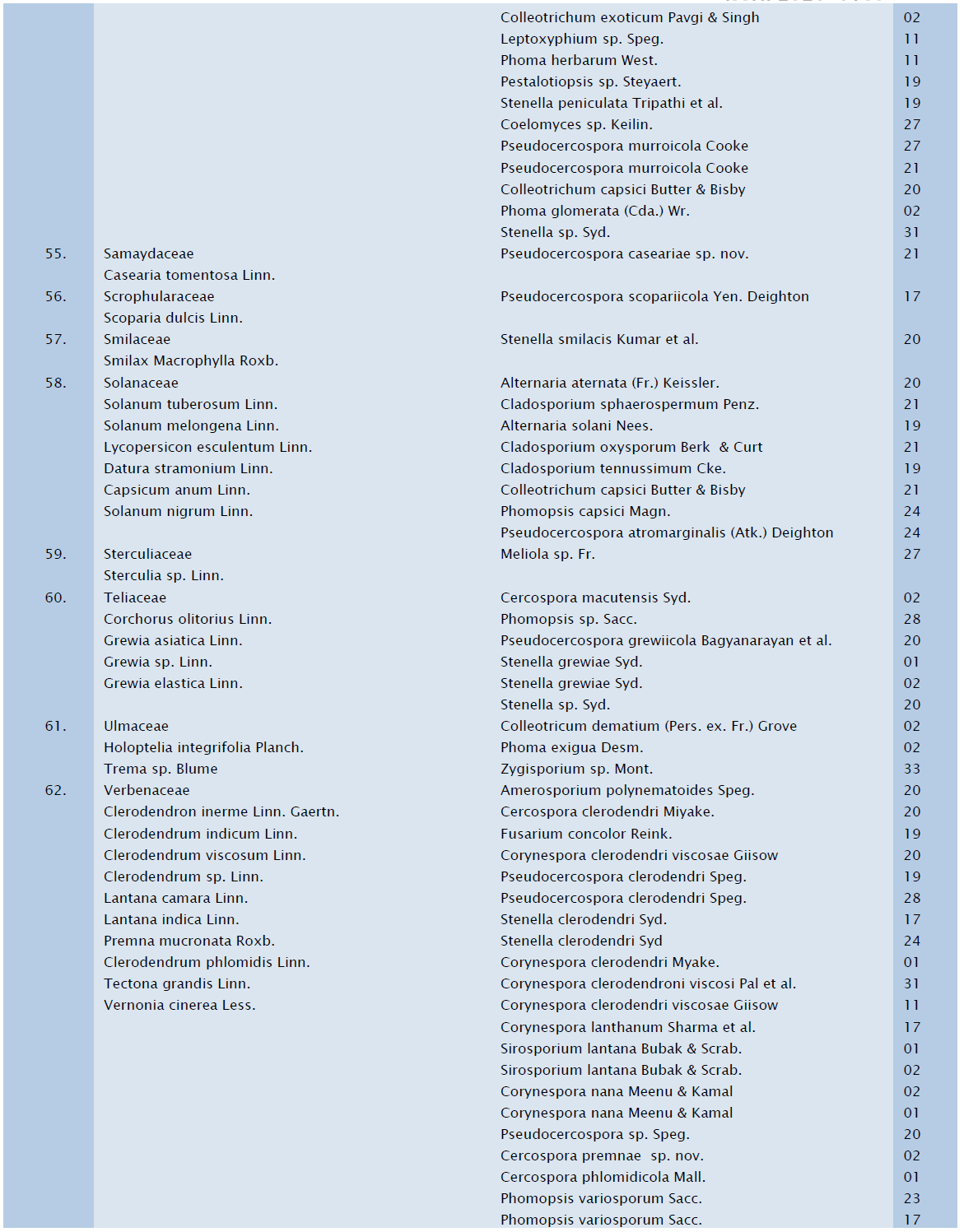

** Places of Collection
A. Sohelwa Wildlife Sanctuary
1. Sohelwa Forest Range East
2. Sohelwa Forest Range West
3. Barahwa Forest Range
4. Bankatwa Forest Range
5. Tulsipur Forest Range
6. Tulsipur unit (Village)
7. Rampur Forest Range
8. Bhabhar Forest Range
B. Shravasti Forest Division
9. Hardutt Nagar Girant Forest Range
10. Kakardari Forest Range
11. Bhinga Forest Range
12. Payagpur Forest Range
C. Bahraich Forest Division
13. Chakia Forest Range
14. Rupaidiha Forest Range
15. Abdulaganj Forest Range
16. Nanpara Forest Range
17. Bahraich Forest Range
18. Kaisarganj Forest Range
D. Katarniaghat Wildlife Sanctuary
19. Katarniaghat Forest Range
20. Nishangara Forest Range
21. Murtiha Forest Range
22. Dharmpur Forest Range
23. Motipur Forest Range
24. Kakarha Forest Range
E. Dudhwa Tiger Reserve
25. Belraya Forest Range
26. Sonaripur Forest Range North
27. Sonaripur Forest Range South
28. Gaurifanta Forest Range
29. Bankati Forest Range
30. Sathiana Forest Range
31. Dudhwa Forest Range
32. Dudhwa Paryatan
F. Kishanpur Forest Division
33. Kishanpur Forest Range
34. Mailani Forest Range
G. Pilibhit Forest Division
35. Pilibhit Forest Range
36. Botanical Survey of India Allahabad
37. Mahabaleshwar Forest Range Satara Maharashtra
The perusal of the table reveals that there are two hundred four angiospermic host plant species representing one hundred fifty two genera belonging to sixty three families are being parasitized by two hundred thirty seven species of foliicolous fungi representing sixty three fungal genera in the whole surveyed area. The sixty three families can be categorized in to four categories. The category first has family Fabaceae with twenty host plants where as category second is being represented by Asteraceae and Moraceae being parasitized by eleven hosts each; category third is represented by Cucurbitaceae, Euphorbiaceae, Menispermaceae, Myrtaceae, Rutaceae, Solanaceae, and Verbenaceae with seven, ten, six, nine, ten, six and ten host plants parasitized respectively. Rest of the fifty three families are being represented by one to five parasitized hosts. No family has been found infected with more than twenty hosts.
Mallotus philippensis, Ficus rumphi, Glycosmis pentaphylla are found to be most susceptible host being parasitized by seven fungus each whereas Euphatorium cannabinium, Haplophragma adenophyllum, Litsea chinensis and Adina cardifolia are found to be infected with six fungus each; Shorea robusta with five fungus; Mangifera indica, Cycas circinalis, Diospyros tomentosa, Artocarpus heterophyllus, Syzygium sp., Mitragyna parvifolia and Tectona grandis has been found to be infected with four fungus each. Rest of the hosts are being found to be infected with two to three fungus and majority are being parasitized by a single foliicolous fungus. There are a number of the hosts which had been collected infected with the same fungus either in different season or in different locality or simultaneously both having different ecological condition shows the adaptability of the fungus in different ecological or climatological conditions.
Twenty one hosts are the new hosts record viz., Tinospora malaverica, Teliacora sp., Euginia sp., Albizzia procera, Lagerstroemia parviflora, Shorea robusta, Clerodendrum sp., Glycosmis pentaphylla, Litsea chinensis, Clerodendrum viscosum, Trichonthes dioica, Murraya sp., Polygonum sp., Albizzia lebbeck, Saccharum spontaneum, Carissa carandas, Grewia elastica, Tectona grandis, Eribotrya japonica, Zizyphus xylophyrus, Tectona grandis whereas twenty three fungal taxon are new species to their respective genera viz., Alternaria bauhinia, Alternaria bahraichensis, Alternaria ichnocarpicola, Alternaria kamalella, Alternaria tejensis, Cercospora oudhensis, Cercospora phlomidicola, Cercospora premnae, Cladosporium fici-caricae, Corynespora bahraichiana, Corynespora carissae, Corynespora celastricola, Corynespora elephantopii, Corynespora ichnocarpii, Corynespora mitragynae, Corynespora pongamicola, Corynespora tomenticola, Meliola flacourticola, Meliola syzyginea, Pseudocercospora caseariae, Pseudocercospora zizyphii, Stenella litseae, Stenella rajendrella,
The review of literature Bilgrami et al., Ellis and Ellis, Jamaluddin et al., Mukerji et al., Sarbhoy et al., Verma et al., [1,2,3,4,5,6,7,8,9,10,11,13] reveals that all the fungus which has been reported to be a new record to Indian mycoflora.
The authors are grateful to Shri Mohd. Ahsan, Chief Wildlife Warden, Govt. of U. P. Lucknow and Shri Ramesh Pandey D. F.O. Katarniaghat Wildlife Sanctuary who very kindly extended us the permission to explore the vegetation under their command. It is our pleasure to extend our deepest sense of gratitude to Prof. Kamal Emeritus Scientist Ex. Prof. Head, Department of Botany, D.D.U. Gorakhpur University, Gorakhpur, for his help in many ways. Our most sincere thanks are due to Prof. S. K. Singh Retd. Prof. and Head, Department of Botany, D.D.U. Gorakhpur University, Gorakhpur, a well-known plant taxonomist of the country and Dr. D. C. Saini Scientist E Institute of Palaeobotany, Lucknow for cordial help in identification of hosts plants and valuable suggestion.The authors are thankful to Chief Curator, H.C.I.O., New Delhi for providing accession numbers of Holotypes of all the fungal specimens deposited. We do extend our most sinciere thanks to Principal, Kisan P. G. College Bahraich for providing library and laboratory facilities. The senior author is thankful to U.G.C. for providing minor Research Project.